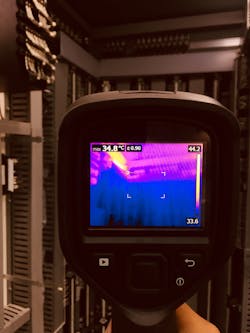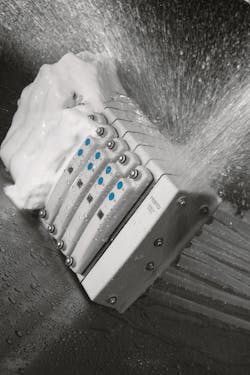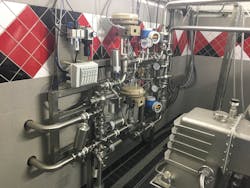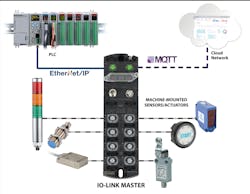For decades, automation components were placed in a protective electrical cabinet and wired to the outside machinery. Planning and execution paid dividends, as these critical devices remained safe and secure inside the enclosure, which is still a viable option. Thermal-management solutions continue to evolve, keeping cabinets cool.
But technology marches on, and the need to provide shelter for components is sometimes outweighed by the need to provide processing availability on the machine. Ethernet connectivity and ingress protection (IP) call cadence for the parade of devices that strut their stuff outside the cabinet. IO-Link has allowed components to communicate, but what IP levels are necessary to mount components where they’re needed?
Methods Machine Tools looks for an IP rating between IP65 and IP68, depending on the location of the device and the environment, says Kevin Davidson, operators manager at its Detroit Technical Center. “If the device is located outside of our machines, the lower IP rating is sufficient, but, as we get near the coolant areas of the equipment, the IP rating increases,” he notes.
“The majority of indoor applications in factory automation require IP65 at a minimum,” says Jeremy Andrews, product manager, industrial field connectivity, at Phoenix Contact, “to protect against any spills or splashes of liquid. The industry as a whole has trended toward IP67 as a standard, which really defines more of a worst-case scenario.” The test for IP67 takes into account submersion in water for 30 minutes at 1 m in depth, which translates to a much larger issue than just a spill from a conveyor or rain water, explains Andrews.
"Machine-mount device protection considerations are much the same as those for control and electrical cabinets," says Bill Dehner, technical marketing engineer, AutomationDirect. "It depends on the environment and requirement for protection, classified as no protection, finger-safe, dust-tight, water-tight, or high-pressure/high-temperature washdown with cleaning solutions, to name several. For example, the protection needed for devices mounted on a machine outdoors in Tucson, Arizona, will differ from the protection required for a machine headed to Seattle. Ratings of IP68 and NEMA 4X are common for providing good resistance to dust, sand, water and washdown.”
Area requirements play a role in determining ingress protection ratings, explains Perry Hudson, key account manager, Pepperl+Fuchs. “I would assume that, at a minimum, you should expect NEMA 12 or IP52,” he says. “When considering these ratings, the two numbers refer to two different designations. The first number refers to protection against solid objects, while the second number refers to protection against water. In this case, the 5 indicates that the housing is protected against dust ingress, while the 2 indicates that the housing protects against direct sprays of water up to an angle of 15° from vertical.”
A NEMA 12 or IP52 rating is considered the minimum for outdoor protection, Hudson notes. “Most control devices designed for external mounting carry a minimum rating of NEMA 6 or IP67 to accommodate a wide range of installations,” he notes, explaining the first digit 6 designates full protection against dust, while the second digit 7 indicates that the housing is protected against the effects of temporary immersion in water between 15 cm and 1 m.
“Most frequently, customers are looking for components rated IP65 or IP67,” says Sandro Quintero, business development for electric automation, Festo (Figure 1). “In both cases, the 6 shows solid-particle ingress protection that is dust-tight. The second integer refers to water ingress: 5 indicates protection against water jets, and 7 is temporary immersion in water. IP69K-rated parts are dust-tight and shielded from high temperature, high pressure water and steam ingress. The level of protection selected depends on the environment.”
The level of ingress protection is application-dependent, declares Tom Jensen, head of system solutions and technology evangelist at Murr Elektronik. “Most technology companies will make one level of protection in line with their target markets,” he explains. “Most providers settle around IP65—dust proof/drip proof, great for logistics, most packaging machines and assembly—and it is only time before subsequent generations of their products will target higher ratings for markets like food and pharma.”
Another consideration is environmental ratings for humidity, shock and temperature. “These, along with IP ratings, will let you know if your components can work in cold rooms or move between environments, such as an automated fork truck moving cold products to a warm space,” explains Jensen.
Technology-enabled
Ethernet and IO-Link communication protocols on compact modules designed in rugged casings with sufficient IP rating have allowed Methods Machine Tools to mount components on the machine where they’re needed, rather than wiring them to the cabinet. “The selection and availability has grown and gives us more options in making the decision whether or not it’s a valid choice to mount outside the panel,” says Methods’ Davidson.
“For decades, we have had fieldbus networks like DeviceNet, CANopen and Profibus,” explains Festo’s Quintero. “Now we have Ethernet-based fieldbuses, like EtherCAT, EtherNet/IP and Profinet. The Ethernet-based fieldbus networks provide higher speeds, greater data capacity, opportunities for the Industrial Internet of Things (IIoT) and a larger number of components with a wider physical distribution than before on the network.” Quintero also agrees that IO-Link is a second important development with machine-mounted I/O designed specifically to control sensors and actuators (Figure 2).
Advancements in device connections allow components that were once confined to a control cabinet to be mounted directly to the machine they are controlling (Figure 3). “No matter how waterproof the body of a device is, it will fail in an outdoor environment if its connections are not sealed properly,” warns AutomationDirect’s Dehner. “A common solution is the use of M12 connectors, which provide temperature- and chemical-resistant sealed connections and can ensure protection up to IP69K.” Machine-mount components are commonly available with connectorized fittings and overall ratings of IP68, NEMA 4X or greater, notes Dehner.
“While NEMA 6 or IP67 is the standard for most external control housings, the use of solid-state components allows for smaller devices that operate with less heat dissipation,” explains Pepperl+Fuchs’ Hudson. “This has led to the ability to offer higher enclosure protection ratings, and with such expanded where external components can be located on machinery.”
Many external control devices are now available with the IP69K rating, which is higher than NEMA 6P, says Hudson. “As with IP67, the first digit means that the enclosures provide complete protection against dust ingress, but in addition, the second rating of 9K means that the housing provides protection against water in the event of direct stream jet cleaning. This level of protection allows the control components to be mounted virtually anywhere on a machine,” he notes.
“Combined with advances in remote I/O communication, fieldbus systems, IO-Link and IIoT in general, machine builders and integrators are now able to place controls close to where they are needed, which also results in shorter installation time, easier maintenance and less production downtime,” explains Hudson.
“The core technologies driving distributed components are capable fieldbus protocols,” says Murr’s Jensen. “IP20 cabinet technology for both programmable logic controllers (PLCs) and drives rely on physical backplane model; the drives must be close to their power supply and the I/O needs to be close to the PLC. Capable fieldbus options allow the backplane to be extended beyond the cabinet, and likewise IP65 power supplies allow power to be placed locally allowing I/O and motion components to work where they are needed.”
This reopens the fieldbus wars—which fieldbus do I use to get happy customers? To get around this, distributed controllers and PLCs commonly include multiple configurable fieldbus options providing an outward-facing fieldbus to connect to the plant, based on acceptance, and an internal fieldbus that will control distributed components, based on performance, and these are not mutually exclusive, explains Jensen.
“Another trend that is affecting distributed components is mobile applications and batteries,” continues Jensen. “More motion components are being produced to use a 48-Vdc supply because this is commonly found in industrial mobile applications now. There is a huge added benefit in that 48 Vdc is much safer than the +700 Vdc supplies used for IP20-based motion control.” IP54 48-Vdc drives and motors have been used in logistic centers for a long time and are finding their ways into the general automation market, he explains.
About the Author
Mike Bacidore
Editor in Chief
Mike Bacidore is chief editor of Control Design and has been an integral part of the Endeavor Business Media editorial team since 2007. Previously, he was editorial director at Hughes Communications and a portfolio manager of the human resources and labor law areas at Wolters Kluwer. Bacidore holds a BA from the University of Illinois and an MBA from Lake Forest Graduate School of Management. He is an award-winning columnist, earning multiple regional and national awards from the American Society of Business Publication Editors. He may be reached at [email protected]

Leaders relevant to this article:




